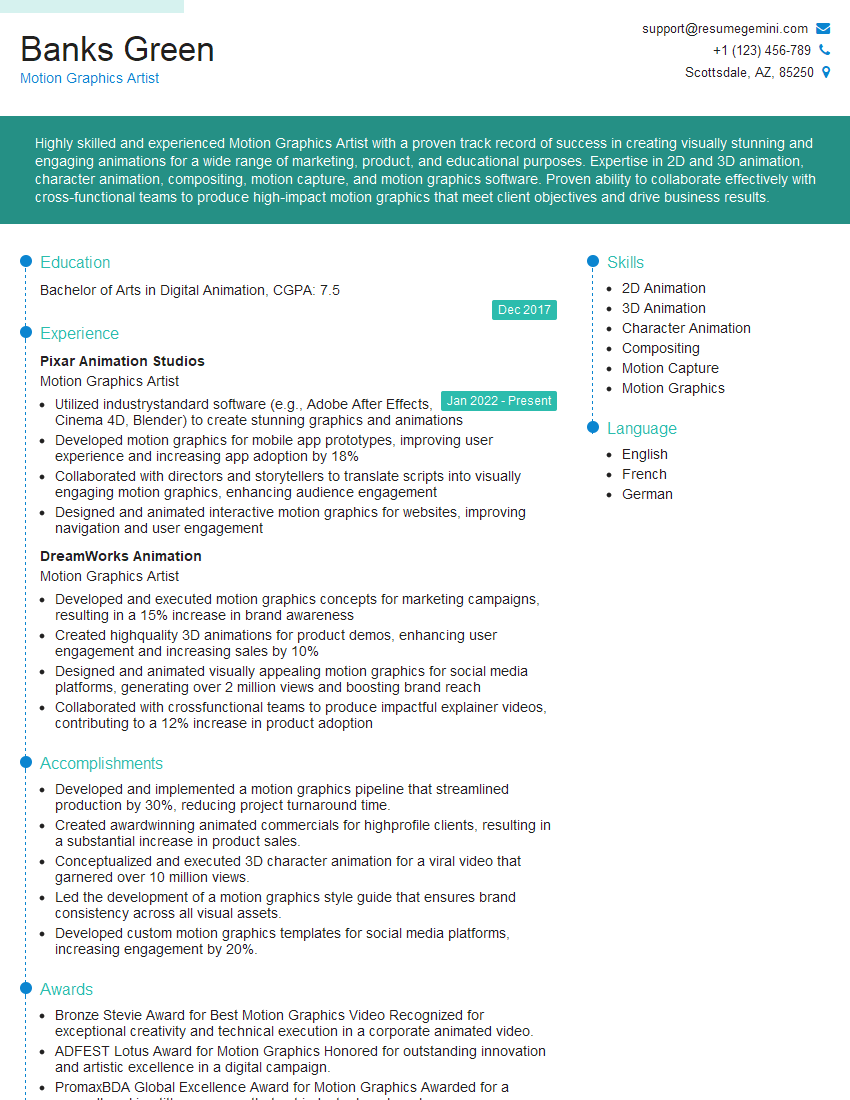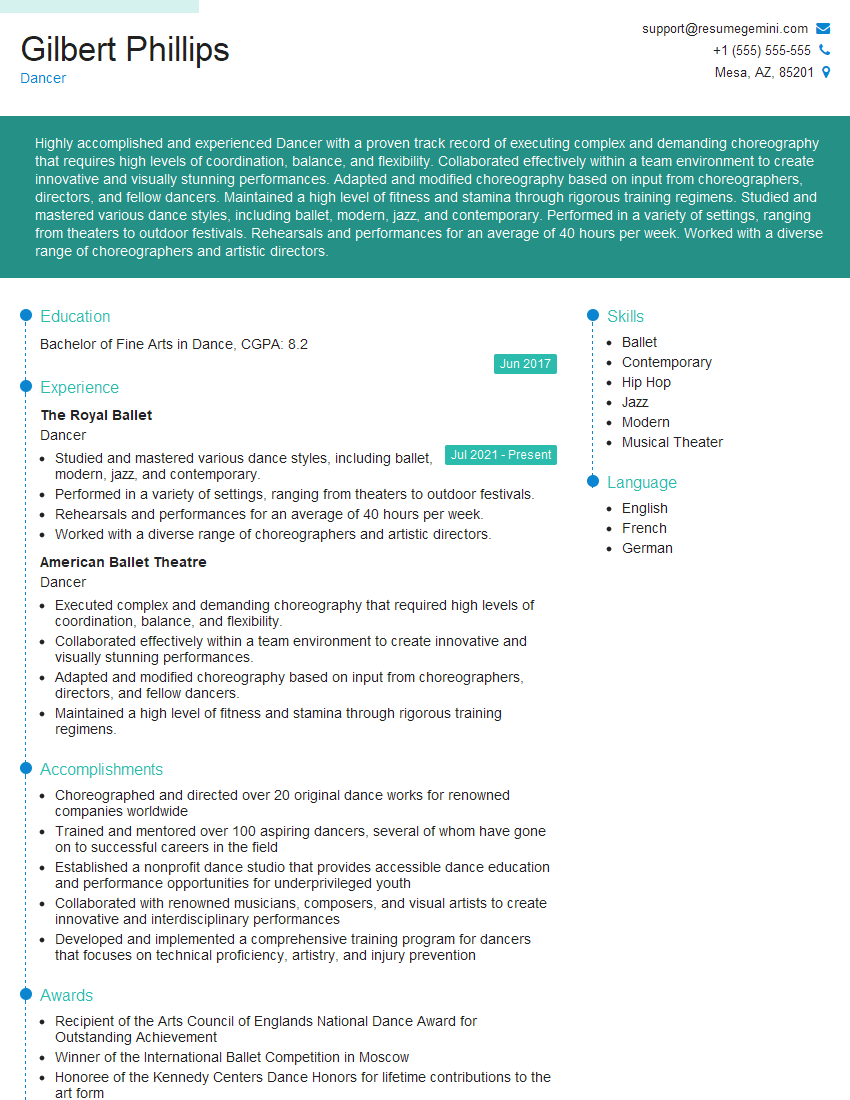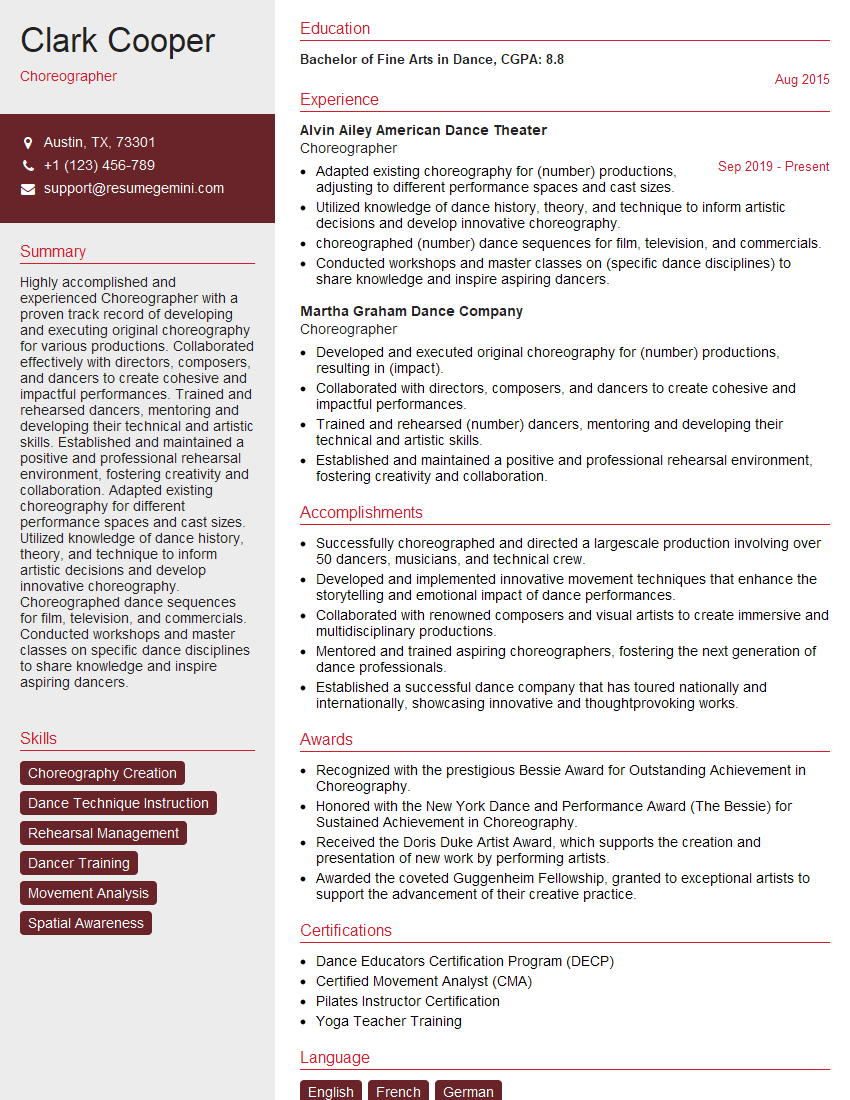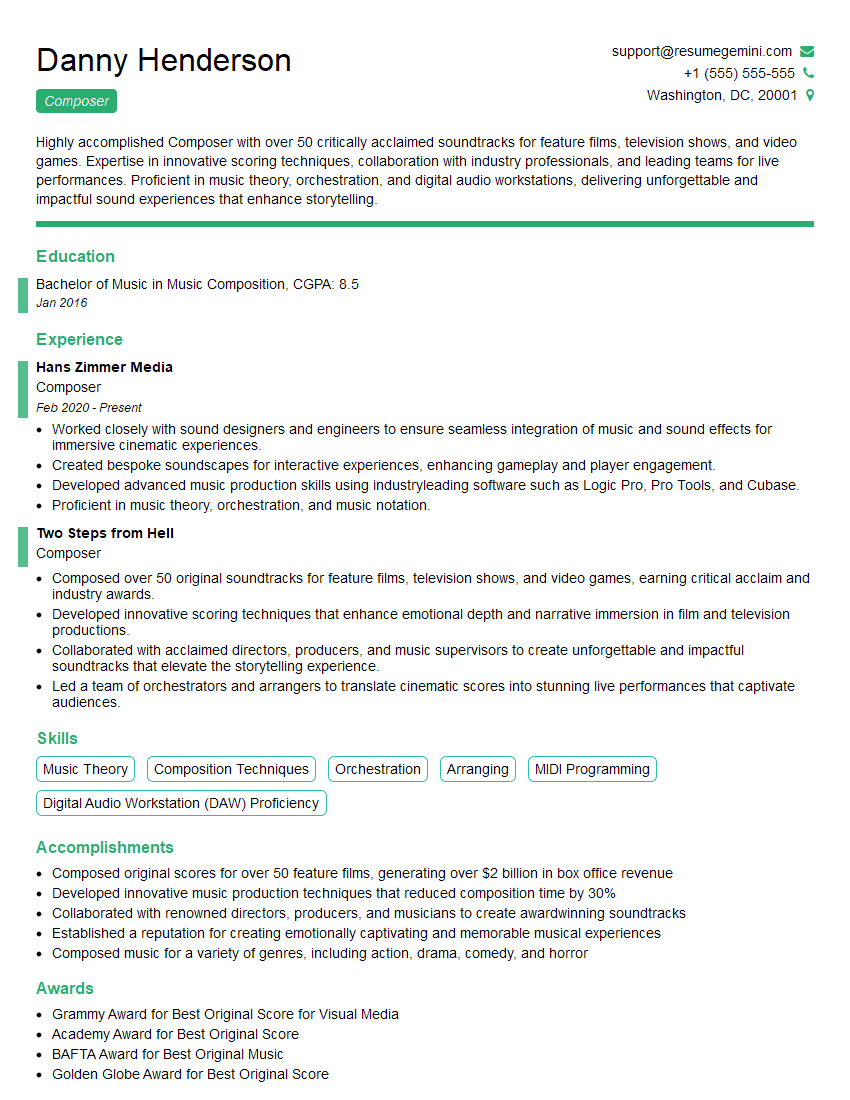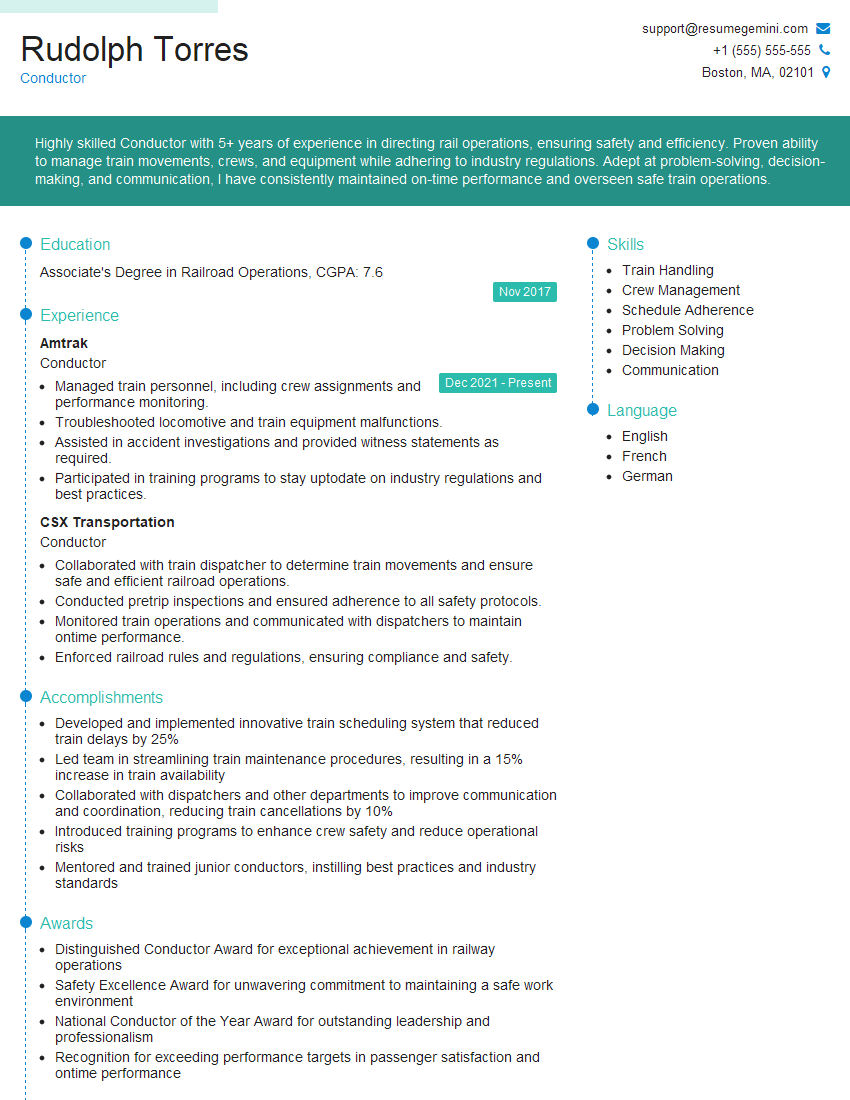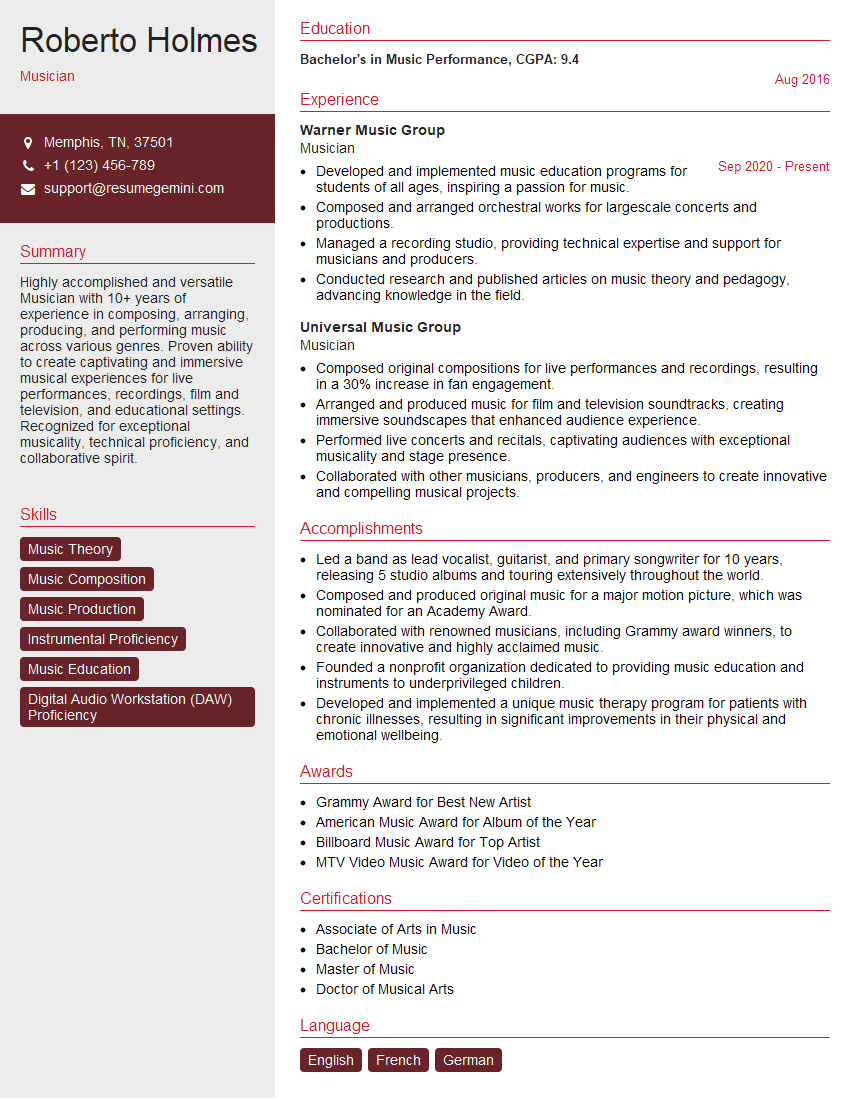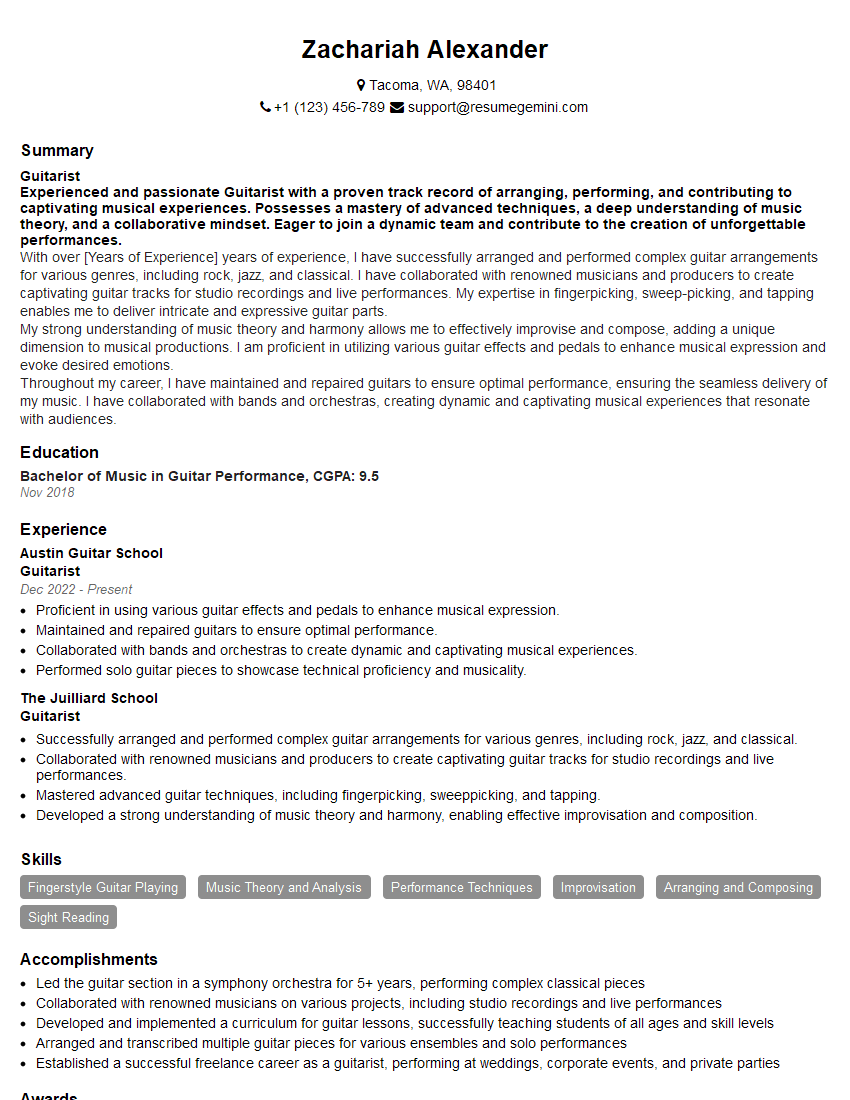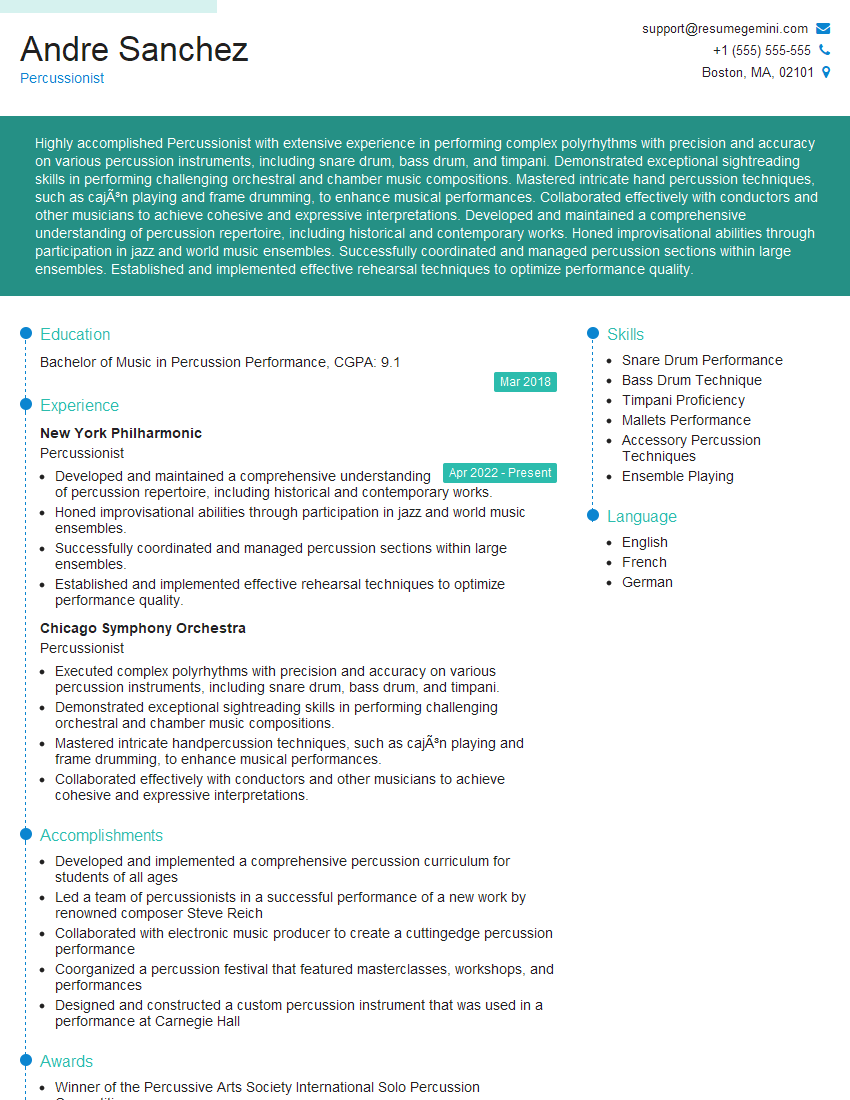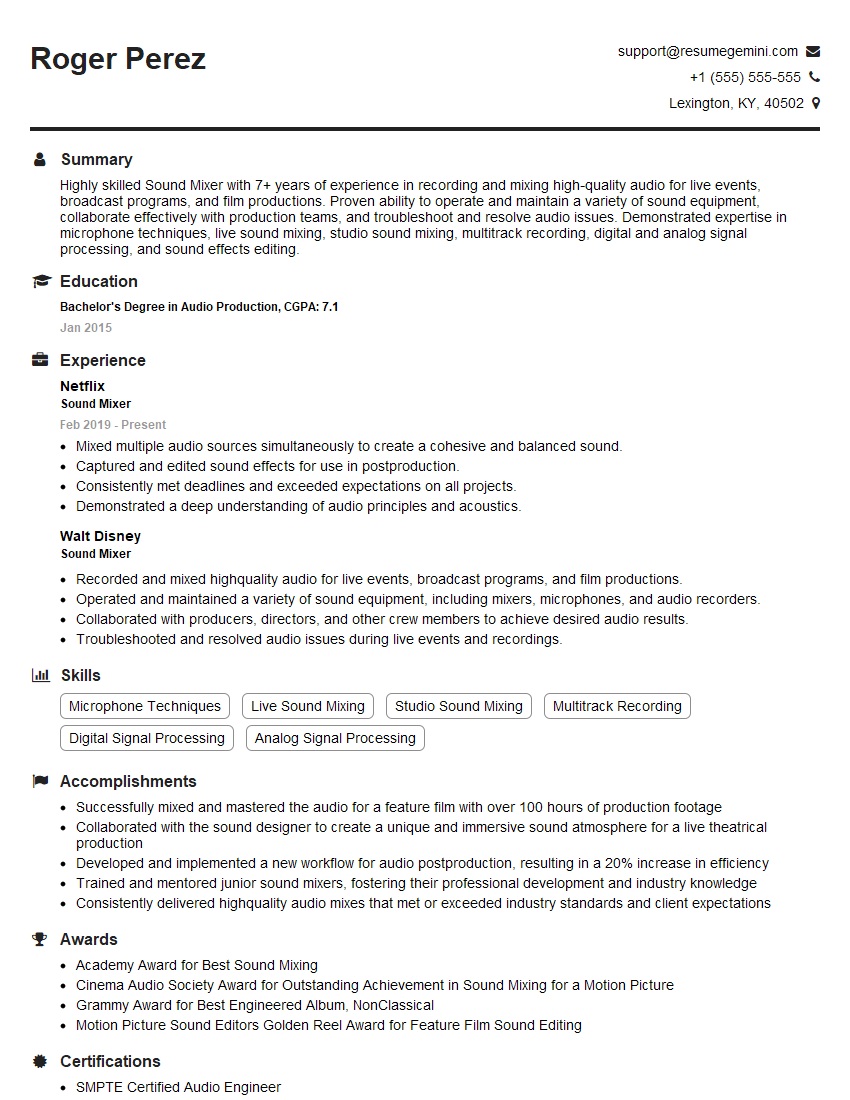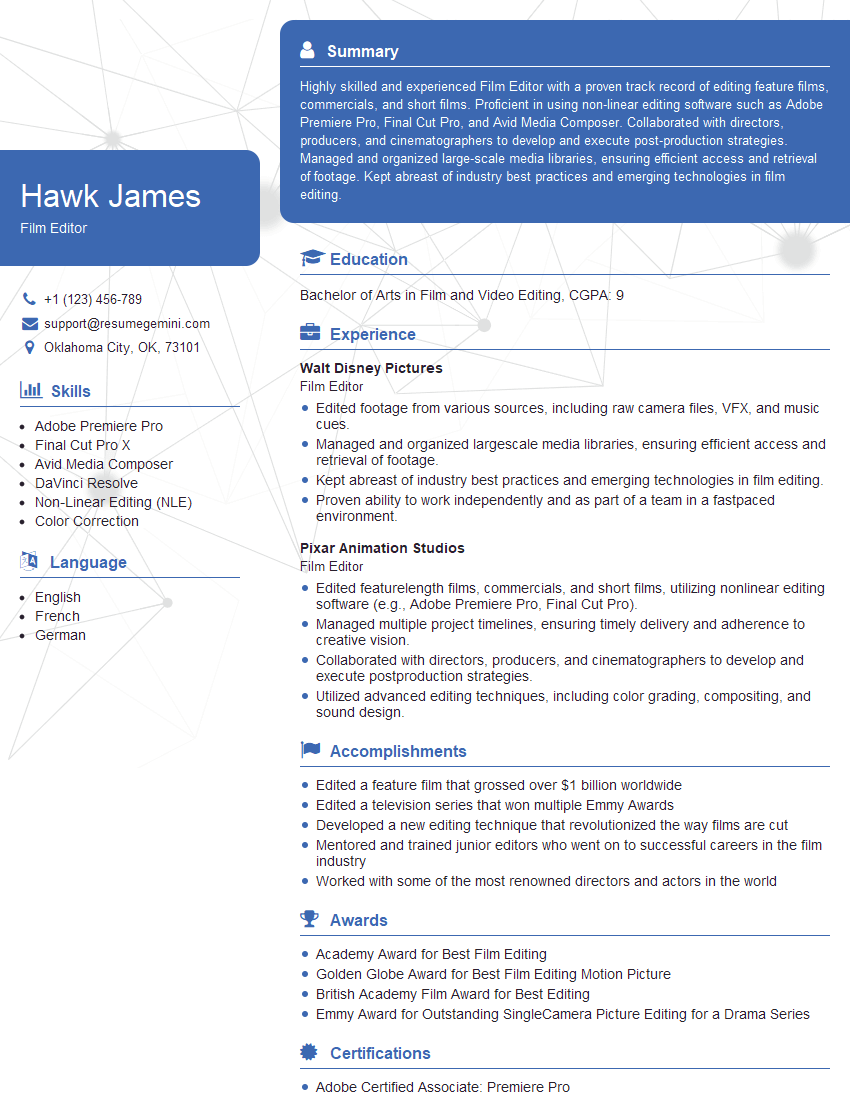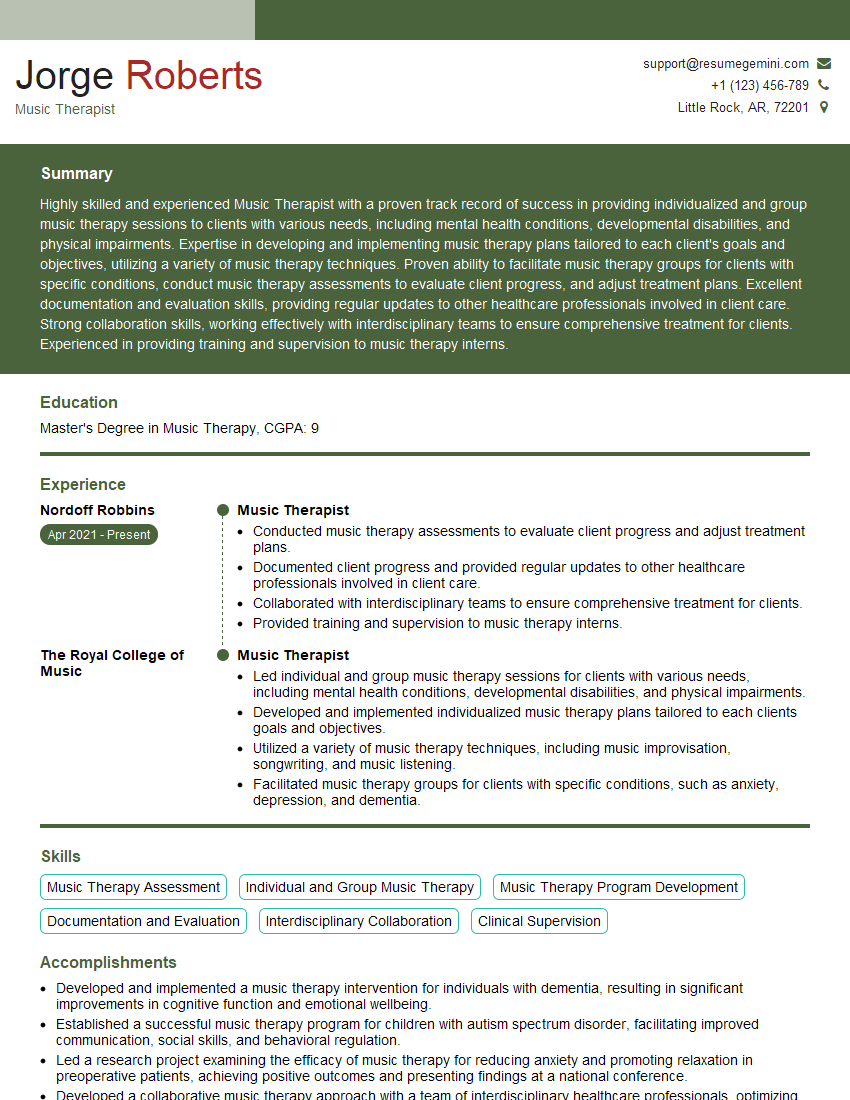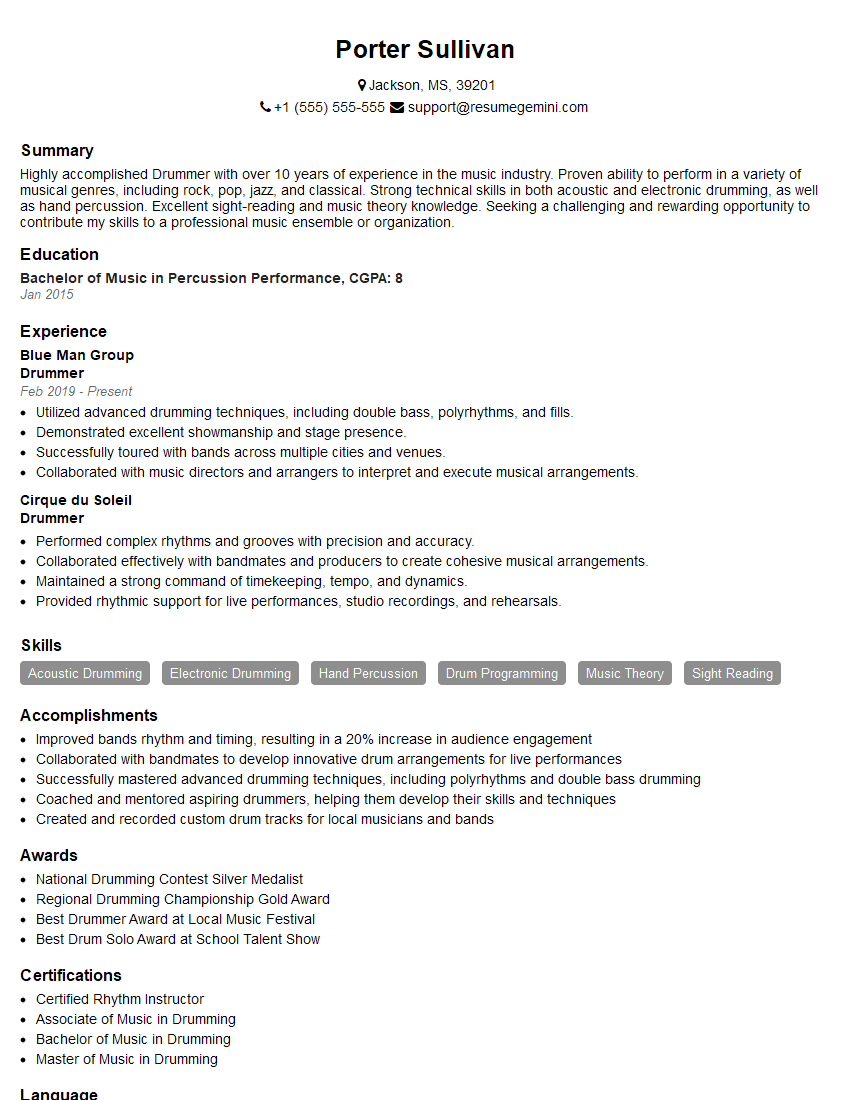Every successful interview starts with knowing what to expect. In this blog, we’ll take you through the top Rhythm and Timing interview questions, breaking them down with expert tips to help you deliver impactful answers. Step into your next interview fully prepared and ready to succeed.
Questions Asked in Rhythm and Timing Interview
Q 1. Explain the concept of tempo and its influence on musical performance.
Tempo refers to the speed or pace of a musical piece, typically measured in beats per minute (BPM). It’s the foundational element that dictates the overall feel and energy of the music. Think of it as the heartbeat of the song. A slow tempo, like in a ballad, evokes a feeling of calmness and introspection, while a fast tempo, like in a pop song, creates excitement and energy.
Tempo influences performance in several ways. Firstly, it directly impacts the rhythmic accuracy and phrasing. A slightly rushed tempo can make a piece sound frantic, while a tempo that’s too slow can make it sound dragging. Secondly, it affects the emotional impact. A carefully chosen and consistently maintained tempo contributes significantly to the emotional arc of a piece, making it more engaging and effective for the listener. Lastly, the tempo impacts the technical demands placed on the performer; a faster tempo requires greater dexterity and precision.
For instance, a piece marked Allegro (fast) will demand a brisk execution, different from a piece marked Largo (very slow), which should be performed with deliberate pacing and expressiveness.
Q 2. Describe different rhythmic notations and their practical applications.
Rhythmic notation is how we write down rhythms on paper. Several systems exist, each with its strengths and applications. The most common system uses note values (whole, half, quarter, eighth, sixteenth, etc.) and rests to represent the duration of sounds and silences. These are combined with time signatures (e.g., 4/4, 3/4) that define the metrical structure.
- Simple Notation: This uses standard note and rest values within a time signature. Example: A simple 4/4 measure might consist of four quarter notes.
[♩♩♩♩] - Compound Notation: This utilizes dotted notes and triplets to represent subdivisions of beats. Example: A dotted quarter note followed by an eighth note occupies the duration of a half note.
[♩.♪]Triplets divide a beat into three equal parts.[♪♩♪] - Syncopated Notation: This involves placing accents on typically weak beats or off-beats, creating a sense of rhythmic surprise and drive. This is often indicated through note placement and dynamic markings.
Practical applications include composing, arranging, and learning music. Composers use notation to write down their ideas, arrangers use it to adapt music for different ensembles, and performers use it to study and interpret the music.
Q 3. How do you maintain consistent tempo while performing live?
Maintaining consistent tempo during a live performance requires a combination of preparation, technique, and listening skills. Before the performance, thorough practice is crucial to internalize the rhythmic structure of the piece. This involves counting along consistently while practicing, using a metronome to develop a sense of accurate timing, and practicing with a click track to simulate a live performance environment.
During the performance, several strategies are employed. Visual cues like a conductor (if there is one), or even the other musicians, help keep a steady beat. Internal counting, coupled with a strong sense of pulse, helps maintain tempo even when subtle variations in expression are desired. Using a click track (in-ear monitoring) can also be beneficial, though some musicians prefer to perform without it to maintain a natural flow. Finally, the most crucial aspect is active listening: a performer needs to constantly monitor their own timing and adjust subtle changes to keep the tempo steady and consistent throughout the performance.
Q 4. How do you identify and correct timing errors in a musical piece?
Identifying and correcting timing errors requires careful listening and analysis. First, one must establish a clear pulse or ‘click’ in their mind (or use an external metronome), and carefully listen to the piece against this steady beat. Any deviations from the established pulse indicate timing inaccuracies.
Once identified, correction strategies can be implemented. This often starts with slowing the tempo slightly, focusing on precise note values, and playing the problematic section very slowly and deliberately. Gradually increasing speed, ensuring that all rhythmic values are correct, allows the timing errors to be refined and corrected. Practice with a metronome or click track can be extremely helpful in honing rhythmic precision. Metronome practice, where problematic sections are isolated and repeatedly played while aligned with the metronome, effectively drills the correct timing.
For example, if a phrase consistently starts late, the musician might practice starting slightly earlier than the established pulse to gradually correct the anticipatory tendency.
Q 5. Discuss the importance of rhythmic phrasing and articulation.
Rhythmic phrasing and articulation are essential elements for shaping musical expression. Rhythmic phrasing refers to the grouping of notes into musical phrases, similar to how sentences are structured in language. Just as pauses and emphasis in speech create meaning, rhythmic phrasing allows for shaping musical ideas and conveying emotion. It involves creating musical tension and release, using rests and varied note lengths to create meaningful musical arcs.
Articulation refers to how notes are attacked and released – legato (smooth and connected), staccato (short and detached), etc. It adds another layer of nuance to rhythmic phrasing. A legato phrase can emphasize the flow of the melody, while a staccato phrase creates a sense of crispness and energy. Together, phrasing and articulation add character and communicative power to music. They allow musicians to create dynamics not just in volume, but also in time.
Imagine playing a simple melody. If you played it with all notes equally spaced and with no emphasis, it would sound lifeless. By applying phrasing and articulation, you can create a story, shaping the emotions conveyed through careful groupings and varied attacks.
Q 6. Explain the concept of syncopation and its role in music.
Syncopation is a rhythmic technique that involves placing accents on off-beats or unexpected places in a measure. It creates a sense of rhythmic surprise and rhythmic interest, often perceived as ‘groove’. Instead of accenting the expected strong beats, the emphasis is shifted to weaker beats or between beats, creating a feeling of rhythmic displacement.
Syncopation plays a vital role in music, adding rhythmic variety and complexity. It can be used to enhance the rhythmic drive of a piece, increase rhythmic interest, and provide a sense of urgency or excitement. Many musical genres, especially jazz, funk, and Afro-Cuban music, heavily utilize syncopation as a central rhythmic device. This rhythmic displacement is often a key component of their characteristic sound.
For example, the characteristic off-beat rhythm in many funk songs is a result of effective syncopation. The feeling of the ‘groove’ is inherently related to the placement of unexpected accents.
Q 7. How do you approach learning a complex rhythmic pattern?
Learning a complex rhythmic pattern requires a methodical approach. The key is to break down the pattern into smaller, manageable parts. Start by identifying the main pulse and then subdivide the pattern into smaller rhythmic units, practicing each unit separately until it’s comfortable.
Use a metronome or click track to practice, focusing on accuracy over speed. Gradually increase the speed as the accuracy improves. Subdivide the rhythm further if necessary; sometimes working with eighth notes instead of quarter notes can make a complex pattern easier to manage. Visual aids, like writing out the rhythm, can be helpful. Consider rhythmic solfège (using syllables like ‘ta’, ‘ti-ri’, etc.) to reinforce the rhythmic pattern internally.
Once the smaller units are mastered, gradually combine them to practice the entire pattern. Recording yourself while practicing can help identify areas that need more attention. Remember to be patient and persistent; learning complex rhythmic patterns takes time and dedication. Don’t be afraid to slow down and repeat sections as needed. Consistency is crucial. Regular practice sessions are more effective than sporadic ones.
Q 8. Describe your experience working with a metronome.
The metronome is an indispensable tool for any musician, serving as a consistent pulse against which to measure and refine timing. My experience spans decades, using it from the initial stages of learning rhythm to complex polyrhythmic exercises and intricate ensemble performances. I’ve used both mechanical and digital metronomes, appreciating the tactile feedback of the former and the flexibility of programming different time signatures and tempos in the latter. Beyond simply keeping time, I employ the metronome to diagnose subtle timing inconsistencies in my own playing, helping me identify areas where I tend to rush or drag. This targeted practice allows for significant improvement in rhythmic precision and control.
For example, when working on a particularly challenging passage, I might start slowly with the metronome, focusing on perfect accuracy before gradually increasing the tempo. This gradual approach ensures that the rhythm is internalized correctly rather than just memorized at a specific speed. I also utilize the metronome to practice different subdivisions, such as eighth notes, triplets, and sixteenth notes, within the larger context of the piece. This multifaceted approach helps develop a nuanced understanding and a highly refined sense of rhythmic precision.
Q 9. How do you maintain rhythm and timing while improvising?
Maintaining rhythm and timing during improvisation is a challenge demanding a strong internalized sense of pulse and a deep understanding of rhythmic structure. It’s not simply about playing notes within a given tempo; it’s about creating a coherent and compelling rhythmic landscape within that framework. My approach involves several key strategies:
- Internal Metronome: Cultivating a strong internal sense of pulse is paramount. This involves extensive practice playing along with a metronome until the beat becomes deeply ingrained. This ‘internal metronome’ allows me to maintain rhythmic stability even without an external timekeeping device.
- Rhythmic Motifs: Improvising often involves developing rhythmic motifs—short, repeated rhythmic patterns—that act as anchors, providing a sense of grounding and direction amidst the spontaneity of improvisation. These motifs help to create a sense of cohesion and unity across the improvisation.
- Harmonic Awareness: The harmonic structure of a piece strongly influences the rhythmic feel. I carefully consider the harmonic changes and how they dictate rhythmic phrasing and articulation. A change in harmony often suggests a change in rhythmic direction.
- Active Listening: Improvisation is a dialogue, not a monologue. I constantly listen to my fellow musicians and adjust my rhythm accordingly. This ensures rhythmic interaction and prevents rhythmic collisions or a lack of cohesiveness within an ensemble context.
For instance, in a jazz solo, I might start with a simple, steady swing feel, then introduce subtle rhythmic variations – syncopations and polyrhythms – building on the underlying groove. This dynamic interplay between stability and variation keeps the improvisation interesting and engaging.
Q 10. Explain the relationship between rhythm and melody.
Rhythm and melody are inextricably linked; one cannot truly exist without the other. Melody provides the horizontal aspect of music, the succession of notes creating the tune, while rhythm provides the vertical aspect—the organization of those notes in time. The rhythm shapes the melody, determining its character and feel. A melody played with a straight, eighth-note rhythm will sound vastly different from the same melody played with a syncopated, swung rhythm.
Think of it like a skeleton and skin: the melody is the skeleton, the structural framework; the rhythm is the skin, adding texture, expression, and personality. The rhythm determines phrasing, accentuation, and overall rhythmic drive of the melody. A simple melody can be transformed dramatically by changing its rhythmic accompaniment. The rhythmic context can even create a sense of implied harmony, adding another dimension to the melodic line.
Q 11. How do you use rhythmic subdivisions to create rhythmic interest?
Rhythmic subdivisions are the smaller units of time within a larger rhythmic framework. Using these subdivisions effectively is crucial for adding rhythmic interest and complexity to music. Instead of simply sticking to the main beat, I incorporate subdivisions like triplets (three notes within the space of two beats), sixteenth notes (four notes within the space of a beat), or even more complex subdivisions to create a sense of rhythmic variety and movement.
For example, a simple four-on-the-floor bass drum beat (d d d d) can be enhanced by adding a syncopated high-hat pattern using sixteenth notes: x d x d x d x d. This adds complexity and rhythmic intrigue without fundamentally altering the underlying pulse. Similarly, using triplets can create a sense of ‘groove’ and swing. The strategic placement of rests and accented notes within these subdivisions also plays a vital role in shaping the rhythmic feel.
Q 12. Describe different rhythmic styles across various genres of music.
Rhythmic styles vary dramatically across different genres. Consider these examples:
- Classical Music: Often characterized by precise, metrically defined rhythms, with emphasis on strong downbeats and adherence to the notated rhythm. However, classical music also exhibits diverse rhythmic elements, including syncopation and ornamentation.
- Jazz: Employs swing feel, where eighth notes are not played evenly but rather with a lilt, emphasizing the off-beat. Syncopation and complex polyrhythms are also common.
- Funk: Often features strong, repetitive rhythmic grooves with a heavy emphasis on the downbeat. Syncopation and rhythmic displacement are also used to create a sense of urgency and excitement.
- Latin Music: Displays a wide range of rhythmic styles, from the driving rhythms of salsa and merengue to the complex polyrhythms of Afro-Cuban music. Clave rhythms are especially characteristic.
- African Music: Characterized by a high level of rhythmic complexity and sophistication, often incorporating polyrhythms and cross-rhythms that intertwine multiple rhythmic layers simultaneously.
Understanding these genre-specific rhythmic conventions is critical for a musician to create authentic and stylistically appropriate music.
Q 13. How do you adjust your timing based on the style of music?
Adjusting my timing based on the style of music is a matter of internalizing the rhythmic feel of the genre. This involves listening extensively to music within that genre, paying attention to nuances of phrasing, articulation, and rhythmic placement. I strive to feel the rhythmic pulse in my body, allowing the music to dictate the rhythmic shape and nuance of my performance.
For example, when playing a reggae piece, I would emphasize the relaxed, laid-back feel inherent in the genre by slightly stretching the durations between notes and employing a subtle off-beat emphasis. Conversely, when playing a piece of heavy metal, the timing would be crisper, more precise, with a powerful emphasis on the downbeat to convey aggression and intensity. This stylistic sensitivity is a key aspect of musical artistry.
Q 14. How do you incorporate rhythmic variations into your performance?
Incorporating rhythmic variations into a performance involves a delicate balance between maintaining the underlying groove and introducing unexpected elements to keep the listener engaged. My approach includes:
- Dynamic Phrasing: Varying the intensity and length of rhythmic phrases can dramatically affect the rhythmic feel. A sudden increase in intensity can create a powerful rhythmic accent, while a gradual diminuendo can build suspense.
- Syncopation: Accenting off-beats adds rhythmic interest and helps to create a more syncopated feel. This is a very effective technique for adding surprise and unpredictability.
- Polyrhythms: Playing multiple rhythmic patterns simultaneously is a powerful way to create a complex and fascinating rhythmic landscape. This requires a deep understanding of rhythmic relationships and strong rhythmic coordination.
- Rhythmic Displacement: Shifting the rhythmic emphasis subtly from one beat to another can create a sense of rhythmic fluidity and surprise.
These techniques allow me to create a dynamic and engaging performance, where the rhythmic aspects are not merely a backdrop to the melody but rather an active participant in shaping the overall artistic expression.
Q 15. How do you use rhythmic devices to create tension and release?
Creating tension and release in music is all about manipulating rhythmic expectations. Think of it like a storyteller building suspense. We achieve this through several rhythmic devices:
- Syncopation: Unexpected accents or stresses on normally weak beats create tension. Imagine a simple march: placing the emphasis on the ‘and’ of a beat instead of the beat itself feels surprising and slightly unsettling. This is syncopation.
- Rhythmic build-ups: Gradually increasing rhythmic density and complexity creates anticipation and heightens tension. Think of a crescendo in a film score, where the music accelerates and becomes more intense before a major event.
- Sudden pauses or rests: A sudden silence after a flurry of notes can be incredibly effective in creating a feeling of release. This is a classic technique in many musical genres.
- Changes in meter: Shifting from, say, 4/4 time to 3/4 can be disorienting and build tension, and reverting back creates a sense of resolution. This is often used in progressive music styles.
- Rubato: Deliberately speeding up or slowing down the tempo adds expressive freedom and enhances the emotional arc of the piece. Think of a romantic ballad, where the rubato might emphasize emotional peaks and valleys.
For example, in a pop song, the verse might have a steady, predictable rhythm creating a sense of calm. The chorus, however, could utilize syncopation and rhythmic build-ups to increase the energy and emotional impact before resolving back to the steadier verse rhythm for release.
Career Expert Tips:
- Ace those interviews! Prepare effectively by reviewing the Top 50 Most Common Interview Questions on ResumeGemini.
- Navigate your job search with confidence! Explore a wide range of Career Tips on ResumeGemini. Learn about common challenges and recommendations to overcome them.
- Craft the perfect resume! Master the Art of Resume Writing with ResumeGemini’s guide. Showcase your unique qualifications and achievements effectively.
- Don’t miss out on holiday savings! Build your dream resume with ResumeGemini’s ATS optimized templates.
Q 16. Explain how you maintain a consistent pulse in a group performance.
Maintaining a consistent pulse in a group performance requires a combination of skills and strategies. A strong conductor or designated timekeeper is often crucial. Here’s how it works:
- Clear Downbeat: The conductor or lead musician needs to clearly establish the downbeat (the first beat of the measure) through precise gestures or rhythmic emphasis. This is the foundation.
- Visual Cues: Consistent and easily understood conducting patterns or head nods from a timekeeper enable musicians to stay synchronized.
- Aural Monitoring: Musicians need to constantly listen to each other and adjust their timing subtly to maintain unity. This is like a group dance where everyone is watching and adjusting to each other.
- Metronome Practice: Rehearsing with a metronome to develop a strong internal sense of time is essential. This develops rhythmic accuracy and independence.
- Body Awareness: Internalizing the rhythm through movement – tapping a foot, nodding the head – can help maintain a solid pulse.
In situations without a conductor, often a drummer or bassist will take on the role of establishing and maintaining the pulse. Their experience and precision are vital.
Q 17. How do you stay in time when working with other musicians?
Staying in time with other musicians is a skill honed through practice and a keen ear. It’s like a conversation, where everyone needs to listen and respond appropriately.
- Active Listening: Constantly listen to the other musicians, not just your own part. This is key to adjusting and responding in real-time to any slight variations.
- Develop a Strong Internal Clock: Metronome practice and playing along with recordings helps cultivate a reliable internal sense of rhythm and timing.
- Focus on the Pulse: Maintain a strong awareness of the overall pulse or tempo of the piece, even if your own part is complex or rhythmically intricate.
- Rehearsal: Thorough rehearsals are absolutely vital for achieving rhythmic cohesion among musicians. The more you play together, the better you’ll become at anticipating and responding to each other.
- Communication: Don’t hesitate to communicate any timing issues you’re experiencing during rehearsals. Open and honest communication is a critical part of the process.
Imagine playing a duet: if one player consistently rushes or drags, the other must adapt to maintain the musical flow. This constant adjustment requires active listening and a flexible approach.
Q 18. How do you deal with discrepancies in tempo between instruments?
Tempo discrepancies between instruments can be a significant challenge. Addressing these discrepancies requires a multi-faceted approach.
- Identify the Source: First, determine which instrument(s) are consistently faster or slower than the rest. This might involve listening carefully, using a metronome during rehearsal, or even recording and analyzing the performance.
- Rehearsal and Communication: Rehearse sections with problematic tempo variations, focusing on establishing a common pulse. Open communication with the musicians involved is essential; discuss the discrepancies and work collaboratively towards solutions.
- Conducting or Timekeeping: A clear conductor or timekeeper can provide a consistent reference point for maintaining tempo. Their gestures and cues can help the group maintain a consistent beat.
- Click Track/Metronome: For recording, a click track or metronome can provide an objective tempo reference, helping each instrument stay aligned. Practice using this ahead of recording to adjust to the click’s precision.
- Individual Practice: Musicians with tempo issues might need to focus on developing their sense of timing through independent practice with a metronome.
Sometimes, subtle tempo variations can add expressiveness, but large discrepancies disrupt the cohesion of the performance. The goal is to find a balance between precision and musicality.
Q 19. Explain the concept of polyrhythms and how they are used.
Polyrhythms involve the simultaneous use of two or more different rhythmic patterns. It’s like having two different clocks ticking at once. The effect can be complex, driving, or hypnotic.
- Example: A common example is a 3/4 rhythm played against a 4/4 rhythm. This creates a sense of rhythmic tension and complexity. The interplay between these rhythms creates a unique texture.
- Application: Polyrhythms are used extensively in various musical genres such as Afro-Cuban music, West African music, and contemporary classical music. They add rhythmic intricacy and depth to the music.
- Creating Polyrhythms: Creating effective polyrhythms requires a strong understanding of rhythmic notation and subdivisions of the beat. Practice is key to mastering the coordination and independence required to play multiple rhythmic patterns simultaneously.
- Improvisation: Polyrhythms also lend themselves to improvisation, allowing musicians to explore complex rhythmic interactions spontaneously.
Consider the rhythmic complexity of music from West Africa, where multiple drummers play interlocking rhythms creating a rich, dynamic, and captivating soundscape. This is a powerful example of the expressive potential of polyrhythms.
Q 20. How do you use rhythmic techniques to enhance the emotional impact of music?
Rhythmic techniques are fundamental to conveying emotion in music. The way we organize and present rhythms profoundly impacts the listener’s emotional response.
- Tempo: A fast tempo can convey excitement, energy, or urgency, while a slow tempo might evoke feelings of sadness, calmness, or contemplation.
- Meter and Rhythmic Patterns: The choice of meter (e.g., 4/4, 3/4, 6/8) and rhythmic patterns can influence the mood. Simple, repetitive patterns might suggest stability or simplicity, while complex or irregular patterns can generate tension or unease.
- Syncopation and Accents: Strategic use of syncopation and accents can add surprise, drama, and emotional weight. Unexpected accents create emphasis and emotional impact.
- Rhythmic Motifs: Repetitive rhythmic motifs can build expectation, then sudden changes or variations can build excitement and climax.
- Dynamics and Rhythm: The interplay between rhythmic patterns and dynamics (loudness and softness) creates a powerful emotional effect. A quiet section with a complex rhythmic pattern can be more intense than a loud, simple one.
Consider a funeral march: the slow tempo, steady beat, and somber rhythmic patterns directly communicate grief and solemnity. In contrast, a lively dance tune’s fast tempo and upbeat rhythms evoke joy and celebration.
Q 21. Explain the role of rhythmic accuracy in creating a professional sound.
Rhythmic accuracy is paramount in creating a professional-sounding performance. Imprecise timing undermines the overall musical integrity and creates a sense of amateurism.
- Ensemble Cohesion: Accurate timing is crucial for ensemble cohesion and clarity. When musicians play precisely together, the music sounds unified and powerful. Inaccurate timing leads to a messy, unfocused sound.
- Professionalism: Rhythmic precision is a hallmark of professionalism. It demonstrates dedication, discipline, and attention to detail. Audiences notice and appreciate this precision.
- Clarity and Articulation: Accurate rhythm enhances clarity and articulation. Each note and phrase is cleanly defined, resulting in a more polished and refined sound.
- Emotional Impact: Accurate rhythmic execution allows the intended emotional impact of the music to be fully realized. Imprecise timing muddies the emotional message.
- Recording Quality: For recordings, accurate timing is even more important. Inaccuracies are easily amplified in recordings and become more noticeable to listeners.
A professional recording session requires meticulous attention to detail in rhythmic precision. Every note needs to be played at the right moment, at the right duration, enhancing the overall professionalism of the final product. This is not just musically satisfying; it’s what separates an amateur production from a polished professional one.
Q 22. Describe a time you had to adjust your timing to accommodate a change in the performance.
Adapting to unexpected changes in performance is crucial. Imagine this: I was conducting a symphony, and a soloist unexpectedly slowed their tempo during a crucial passage. My immediate reaction was not to panic, but to subtly adjust my baton technique. I focused on maintaining the overall pulse through my body language, subtly guiding the orchestra to follow the soloist’s adjusted pace while simultaneously ensuring the overall phrasing and dynamic remained consistent. This involved a shift from a strictly metronomic approach to a more nuanced, empathetic conduction style, actively listening and reacting to maintain musical cohesion and avoid a jarring disruption. It’s akin to a tightrope walker adjusting their balance – a constant process of monitoring and micro-adjustments.
Another instance involved a live jazz performance where a sudden power surge caused our instruments to momentarily lose power. We had to quickly adapt the tempo and rhythm of our improvisation, extending rests where needed, while ensuring the musical flow remained uninterrupted and the audience remained engaged. The collective ability to adapt to the power outage showcased the importance of strong musical intuition and flexibility.
Q 23. How would you assess the rhythmic skills of another musician?
Assessing a musician’s rhythmic skills goes beyond simply checking if they can play in time. I look at several key aspects. Firstly, I listen for their sense of pulse – do they feel and maintain a steady beat internally? Secondly, I assess their subdivision – can they accurately divide the beat into smaller units like triplets or eighth notes? Thirdly, I evaluate their rhythmic accuracy, particularly in complex rhythmic patterns and syncopations. This involves observing their consistency and precision. Lastly, and arguably most importantly, I observe their rhythmic flexibility – can they feel and respond to rhythmic shifts and nuances without losing the overall groove? I would use exercises like playing simple rhythms at different tempos, adding complex rhythmic figures, and improvising over rhythmic backing tracks to evaluate these skills. A musician with strong rhythmic skills isn’t merely accurate; they exhibit a deep internalization of rhythm, allowing for both precision and expressiveness.
Q 24. Describe your method for practicing rhythm and timing.
My rhythm practice is multifaceted and involves a combination of technical exercises and musical application. I start with basic rhythmic exercises using a metronome, focusing on accuracy and consistency at various tempos. I progress to more complex rhythms, often incorporating subdivisions and syncopations. I then apply these skills in musical contexts, working on grooves, fills, and playing along with backing tracks. For instance, I’ll dedicate time to playing along with drum loops or backing tracks, focusing on internalizing the groove and maintaining a strong sense of pulse. I also incorporate improvisation, allowing myself to freely explore rhythmic variations while staying grounded in the foundational rhythmic principles. Regular practice helps develop both technical proficiency and musical expressiveness. I also focus on listening to diverse musical styles to broaden my rhythmic vocabulary and understanding.
Q 25. How do you ensure accurate timing in post-production audio editing?
Ensuring accurate timing in post-production audio editing is crucial for a polished final product. I use a combination of techniques to achieve this. The most crucial step is using high-quality recording equipment to minimize timing issues right from the start. During editing, I rely heavily on digital audio workstations (DAWs) that provide tools for precise timing manipulation such as time stretching, quantization, and beat matching. I’ll often use the DAW’s grid to align audio precisely to the beat. If there are significant timing issues, I’ll carefully edit, using techniques like cutting and pasting to realign individual notes or phrases. For subtle timing corrections, I might use time-stretching algorithms to adjust the tempo of individual sections without significantly altering the pitch. Throughout this process, constant critical listening is paramount to ensure that the final timing is not only accurate but also musically satisfying.
Q 26. How do you create a sense of rhythmic drive and momentum?
Creating a sense of rhythmic drive and momentum relies on several strategies. One essential element is maintaining a consistent, strong pulse. This foundation provides a sense of stability and allows for the introduction of variations without losing the underlying groove. Dynamic variations play a significant role; controlled crescendos and diminuendos can amplify the sense of forward momentum. Syncopation, or the rhythmic displacement of accents, can add excitement and unpredictability to maintain listener engagement. Finally, effective use of rhythmic phrasing – grouping notes into musical units – helps create a sense of shape and direction. Think of it like a story with rising and falling action; careful phrasing ensures the listener feels the journey, not just a sequence of notes. For example, a gradual increase in tempo during a crescendo can powerfully build momentum, whereas rhythmic rests strategically placed can add anticipation and release.
Q 27. Explain the impact of rhythmic irregularities on the listener.
Rhythmic irregularities, when used effectively, can create a wide range of emotional and musical effects. However, uncontrolled irregularities can lead to a lack of groove, making the music sound sloppy or unfocused. Subtle rhythmic variations, such as swing feel in jazz, can add character and human feel. More pronounced rhythmic changes can create tension, surprise, and even a sense of unease. For instance, a sudden rubato (temporary departure from strict tempo) in a classical piece can add emotional weight to a climax. However, excessive or inconsistent rhythmic irregularities can disrupt the flow of music, leaving the listener feeling disoriented or confused. The impact entirely depends on the context, the intentionality, and the listener’s expectations and preferences. It is often a subtle dance between precision and controlled improvisation.
Q 28. Describe your approach to teaching rhythm and timing to others.
My approach to teaching rhythm and timing emphasizes a holistic understanding, moving beyond mere technical exercises. I begin by building a strong foundation in basic rhythmic concepts, using games, clapping exercises, and body percussion to make learning fun and engaging. Gradually, I introduce more complex rhythms and concepts, always emphasizing the importance of internalizing the pulse. I encourage students to listen actively to music across various genres to broaden their rhythmic awareness. I believe in fostering creativity, allowing students to explore their rhythmic ideas within the established framework. I use a combination of individual instruction, group exercises, and performance opportunities to solidify their understanding. Feedback focuses not only on accuracy but also on musicality and phrasing. It’s a journey of developing both a strong technical understanding and an expressive connection to the music.
Key Topics to Learn for Rhythm and Timing Interview
- Fundamental Rhythmic Concepts: Understanding meter, tempo, and rhythmic notation. Explore different rhythmic patterns and their variations.
- Timing and Groove: Mastering the nuances of playing or producing music in time. Analyze the interplay between rhythmic precision and expressive phrasing.
- Syncopation and Polyrhythms: Delve into the complexities of off-beat rhythms and the interplay of multiple rhythmic layers. Practice identifying and creating syncopated patterns.
- Practical Application: Discuss how you apply rhythmic understanding in your chosen field (e.g., music production, composition, performance, music therapy). Prepare examples of your work.
- Problem-Solving in Rhythm and Timing: Explain how you approach challenges related to rhythmic accuracy, complex rhythmic structures, or improvisational settings. Showcase your analytical skills.
- Transcription and Analysis: Demonstrate your ability to notate and analyze rhythmic passages from various musical styles. Highlight your analytical skills.
- Technological Applications (if relevant): Discuss your experience with software or hardware that helps with rhythmic precision, such as DAWs, drum machines, or notation software.
Next Steps
Mastering rhythm and timing is crucial for success in many creative fields. A strong understanding of these concepts demonstrates a high level of musicality, precision, and technical proficiency – highly valued attributes in competitive job markets. To maximize your job prospects, creating an ATS-friendly resume is essential. ResumeGemini is a trusted resource to help you build a professional and impactful resume that highlights your skills effectively. Examples of resumes tailored to Rhythm and Timing roles are available to guide you; use these examples as inspiration to showcase your unique strengths and experience.
Explore more articles
Users Rating of Our Blogs
Share Your Experience
We value your feedback! Please rate our content and share your thoughts (optional).
What Readers Say About Our Blog
Hello,
We found issues with your domain’s email setup that may be sending your messages to spam or blocking them completely. InboxShield Mini shows you how to fix it in minutes — no tech skills required.
Scan your domain now for details: https://inboxshield-mini.com/
— Adam @ InboxShield Mini
Reply STOP to unsubscribe
Hi, are you owner of interviewgemini.com? What if I told you I could help you find extra time in your schedule, reconnect with leads you didn’t even realize you missed, and bring in more “I want to work with you” conversations, without increasing your ad spend or hiring a full-time employee?
All with a flexible, budget-friendly service that could easily pay for itself. Sounds good?
Would it be nice to jump on a quick 10-minute call so I can show you exactly how we make this work?
Best,
Hapei
Marketing Director
Hey, I know you’re the owner of interviewgemini.com. I’ll be quick.
Fundraising for your business is tough and time-consuming. We make it easier by guaranteeing two private investor meetings each month, for six months. No demos, no pitch events – just direct introductions to active investors matched to your startup.
If youR17;re raising, this could help you build real momentum. Want me to send more info?
Hi, I represent an SEO company that specialises in getting you AI citations and higher rankings on Google. I’d like to offer you a 100% free SEO audit for your website. Would you be interested?
Hi, I represent an SEO company that specialises in getting you AI citations and higher rankings on Google. I’d like to offer you a 100% free SEO audit for your website. Would you be interested?
good

